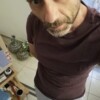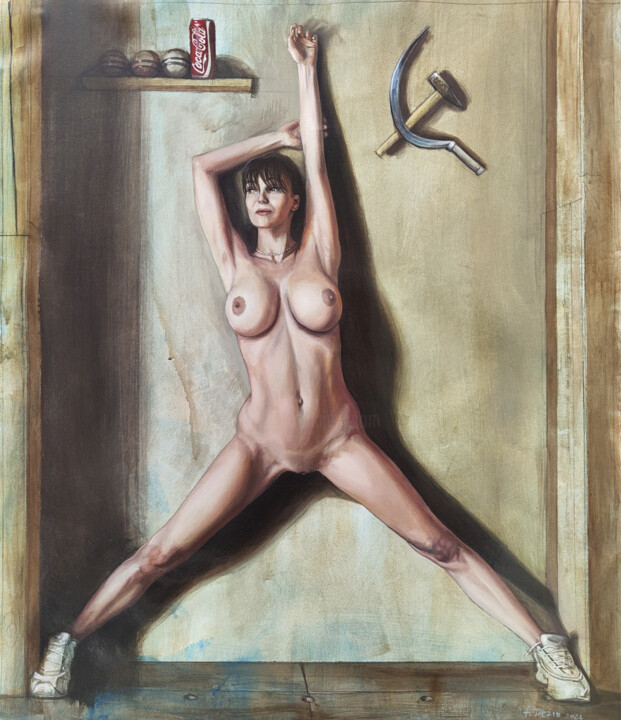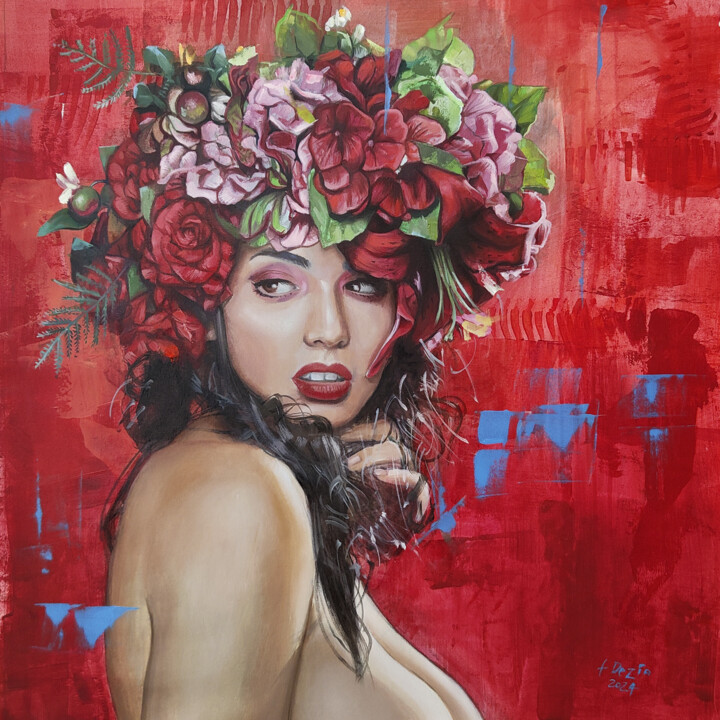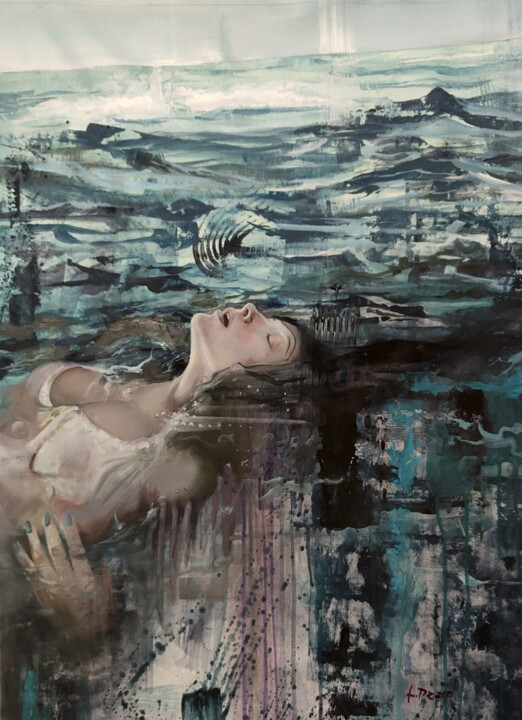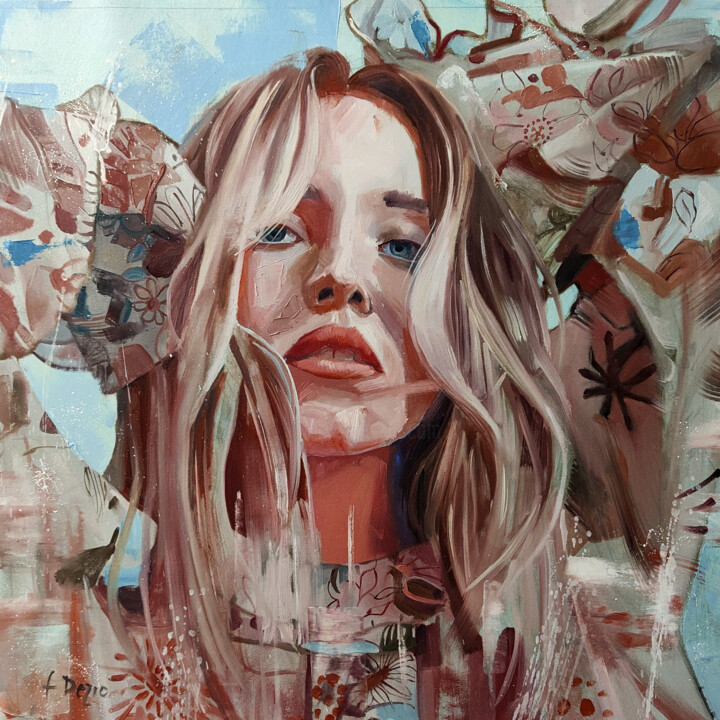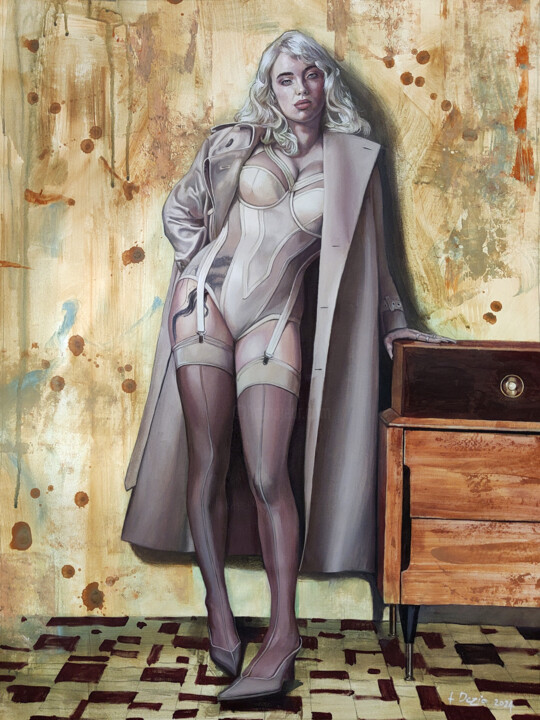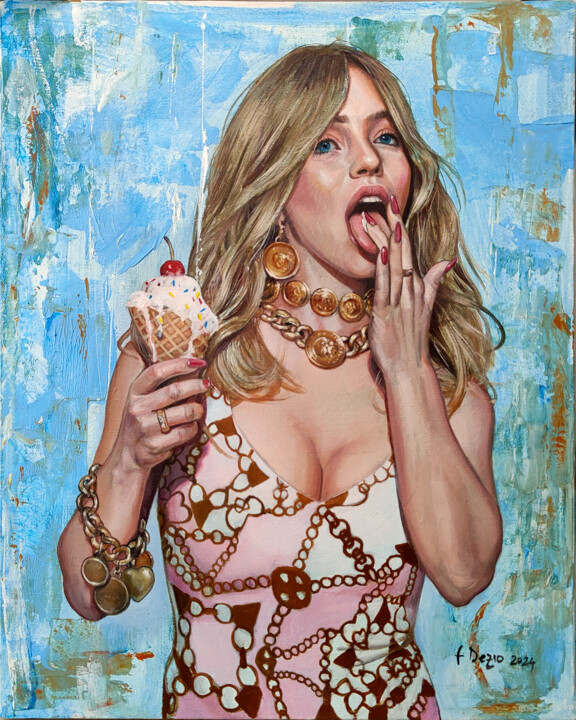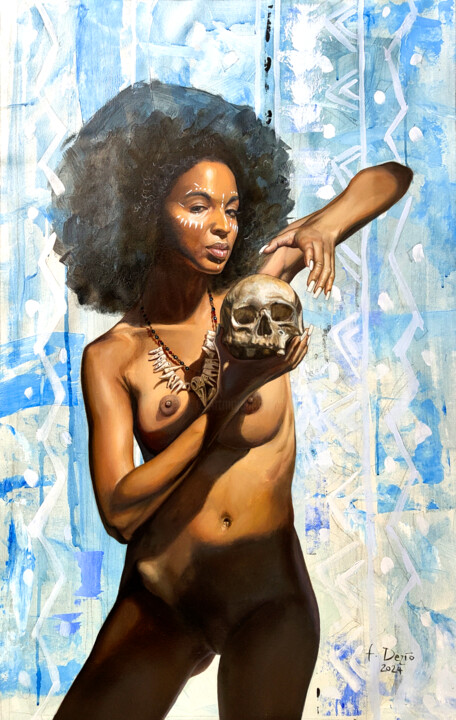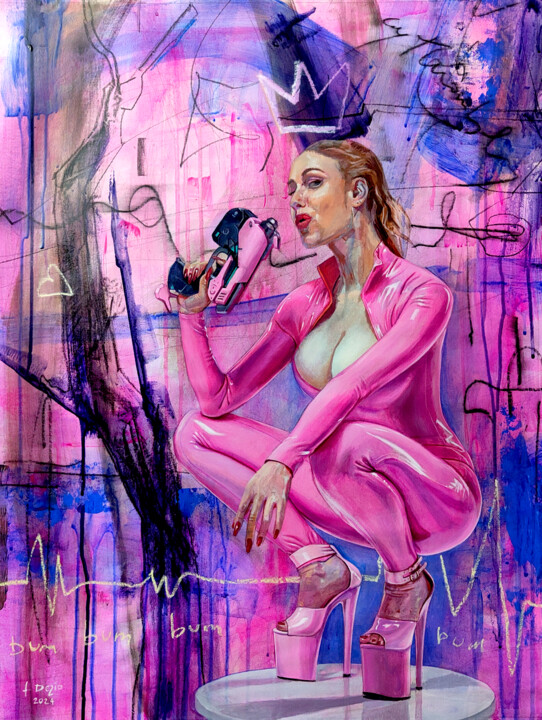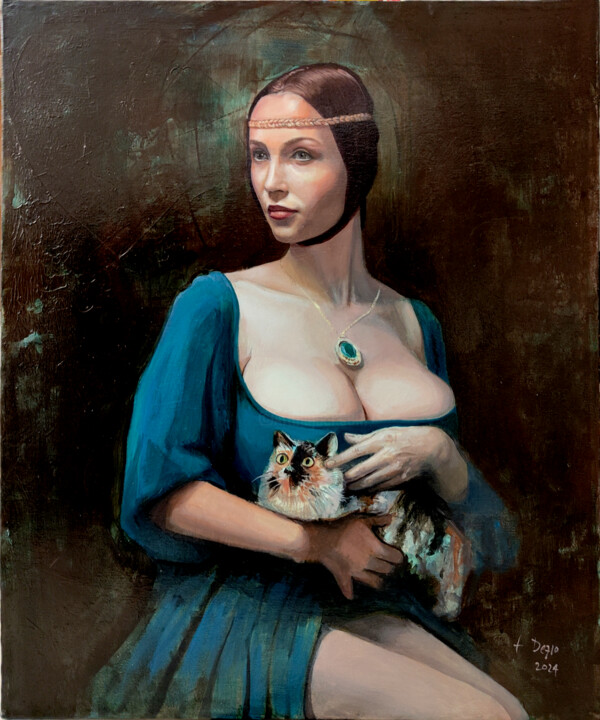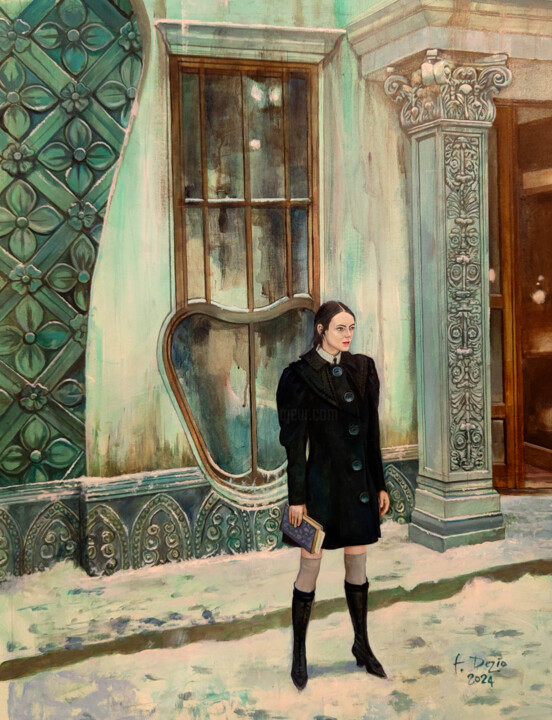What motivated you to create art and become an artist? (Events, feelings, experiences...)
I come from technical studies, so my training is self-taught. As a boy I always loved to draw, imitating the style of some Marvel illustrators or, growing up, that of the Argentine school of authors such as Enrique Breccia, Juan Zanotto, Juan Giménez... to name a few. During my adolescence, to teach me some secrets of oil painting ("at the first") was a distant relative of mine, a naïve painter (he painted landscapes and religious-themed paintings, because that was the reference clientele): from there it all started... Then, I continued on my own, approaching the surrealist genre. I worked as a laborer and in my spare time I painted, without any particular pretensions or ambitions. I point out that this (difficult, devastating) experience, I later recounted in a novel published by Feltrinelli Editore in 2004, entitled Nicola Rubino entered the factory and became a literary case - Roberto Saviano was among the first to review it and was enthusiastic about it: to this day, that text is considered an indispensable reference for factory and precariat fiction. Starting in 2014, in parallel with my activity as a writer, I began to collaborate with various small publishers as a graphic designer and illustrator (here is an example; all the covers made for this publisher are mine: https://www.terrarossaedizioni.it/) ... But the call toward more traditional painting techniques (such as, e.g., oil painting) was no longer elusive and here I am.
What is your artistic background, techniques and subjects you have experimented with so far?
Considering the classics, undoubtedly Klimt, Schiele, Caravaggio, Velasquez, Dali, Magritte, Freud, the Pre-Raphaelites but also a figurative painter much mistreated by critics (and, instead, beloved by Salvador Dali): William Adolphe Bouguereau. I also owe a great deal to the experimental approach, in literature, of a writer like William Burroughs, inventor of the cut-up and whose equivalent, in painting, is pareidolia, an instinctive automatism that I make use of in my creations, on a subconscious level... Without disdaining what is considered "low," kitsch, or lobrow art, I refer to the pop surrealism proposed by alternative magazines like Hi Fructose and Juxtapoz. Of the contemporaries I adore Jenny Saville, Paul Laurenzi, Michael Carson, Alex Canevsky, John Currin, Eric Fischl, so just to name the first ones that come to mind and which, undoubtedly, I rag on. Being an illustrator as well, I greatly appreciate (and am noticeably influenced by) American "golden age" illustrators such as Robert McGinnis, Norman Rockwell, or from the pulp or fantasy genre (Frank Frazetta). I am a devotee of Italian erotic comics (Milo Manara, Vittorio Giardino, Crepax, Paolo Eleuteri Serpieri, Baldazzini, etc.)... My favorite techniques are Oil, acrylic, watercolor and pencil. I recently bought a set of oil pastels and hope to start experimenting with those as well...we'll see.
What are the 3 aspects that differentiate you from other artists, making your work unique?
I think three hallmarks are versatility (or multifacetedness), curiosity (without which nothing I do could subsist), irony (and certain taste for provocation).
Where does your inspiration come from?
I let myself be invaded (in an attempt to cipher, reset, sequence, recompose or even decompose) by all kinds of visual messages, whether they come from reality or from the world of media (social, blogs, etc.). Not secondary, the stimuli provided to me by literature (Burroughs, Volodine, Jeauffray, Houellebecq, Easton Ellis...) and, we said, by subcultures (comics, alternative rock).
What is your artistic approach? What visions, sensations or feelings do you want to evoke in the viewer?
fundamentally I would call myself a figurative painter (and I am proud of it, the avant-gardes and any form of disdain for craftsmanship in art, have become outdated, museum-like, so, we might as well go back to the origins, trying, if possible, to reinvent them), but mine is not pure realism, I often insert elements of abstraction or I disrupt and fragment the image to ward off hyperrealism (or any kind of depersonalizing photographic recalculation): virtuosity for its own sake does not interest me.
What is the process of creating your works? Spontaneous or with a long preparatory process (technical, inspired by art classics or other)?
I would say that both factors come into play. Sometimes the design phase takes up more time than the realization phase (which means, upstream, doing continuous iconographic research to come up with a viable idea). I have an endless catalog of images that I draw on (or allow myself to be fascinated by) and that I reinvent by indulging my own aesthetics (I don't limit myself to a single attempt, I do several trials and choose the one that convinces me the most); it almost always goes like this... however, it may happen that I get there more directly (or spontaneously), but it is not the norm. The ideational part is not visible, but it is the one that makes the difference, between me and other painters....
Do you use a particular working technique? if yes, can you explain it?
If we are talking about painting on canvas, the iter is consolidated: the preparatory phase (sketches and first drafts) I make them in acrylic and then - when the material becomes unmanageable - I switch to oil painting, which having longer drying times allows me to be able to shade-refinish with greater accuracy what I started (and, sometimes, to remedy some errors in setting).
Are there any innovative aspects to your work? Can you tell us what they are?
It is difficult (if not impossible, I think) to come up with something new in this day and age (and what was avant-garde yesterday is now to be considered retro). I like to create alchemy with my art-which, as you may have guessed, is very much contaminated by musical influences, from popular and underground comics, from psychedelia, from cinema, from fiction-if there is anything original in my work lies in the fact that I am very sensitive and receptive to all kinds of influences. It is that, not coming from academia, I have a taste for experimentation, for trial and error, for false trails. Since my dedication is to figuration, in order not to trivialize this theme (or abuse it in a qualunquistic way), I almost always introduce elements of abstraction (and action painting) or representational anomalies in which I go to sublimate certain taste for provocation, the grotesque.
Do you have a format or medium with which you feel most comfortable? if so, why?
I would say my technique of choice is oil painting. One format (of canvas) that I am comfortable working on is 60x80, which gives me a way to accentuate the gestural component, making extensive use of wide brushes, palette knives, rollers.
Where do you produce your work? At home, in a shared workshop or in your laboratory? And in this space, how do you organize your creative work?
I produce everything at home, where I have carved out a corner where I have the PC workstation, a studio easel, a cart that holds acrylic and oil paints and which I have modified so that at the same time it is also a small table on which I place the palette, plus a chest of drawers where I have watercolors, pencils, pastels and various accessories.
Does your work lead you to travel to meet new collectors, for fairs or exhibitions? If so, what does it bring you?
At the moment no, I have to admit that I am rather sedentary. I only hang out with gallery owners in my area, and I am sorry about that, because I would like to expand my circle.
How do you envision the evolution of your work and career as an artist in the future?
Deepening my taste for figuration (specializing even better in this), and perhaps tending more toward less controlled and more textural painting. Give up, when possible, my perfectionism and indulge more and more in drifts where I go to break up the image, decompose it, fragment it further... this could be a possible evolution.
What is the theme, style or technique of your latest artistic production?
These are often examples of glamorous femininity (or for gothic, dark aesthetics, but without exaggeration) placed in alienating contexts and from which one can infer the unapologetic taste for provocation and irony. I generalize, because I also go to themes in which I express social criticism (see, for example, the very recent "Joy and Revolution").
Tell us about your most important exhibition experience?
In February I will have a solo show (with the best of my production), at the Artimmagine gallery here in Altamura. I hope to do more.
If you could create a famous work in art history, which one would you choose? And why?
Probably Gustav Klimt's Danae, because of the huddled figure in the fetal position and the pose, which I find to be of an exhausted voluptuousness and excruciating sensuality, unparalleled. It is a painting of dizzying beauty. And vertigo is what I would like to offer my audience with my works.
If you could invite a famous artist (living or dead) to dinner, who would it be? How would you suggest they spend the evening?
I would have liked to meet Salvador Dali, to try to see if on convivial occasions such as this, he would have thrown off his mask; more like, considering the subject, I would have left it to him.







 Olimpia Gaia Martinelli
Olimpia Gaia Martinelli
